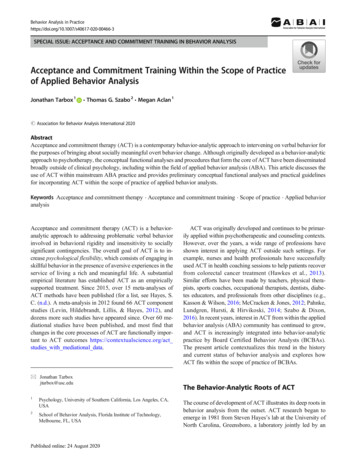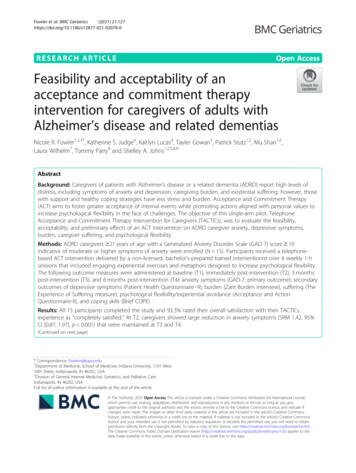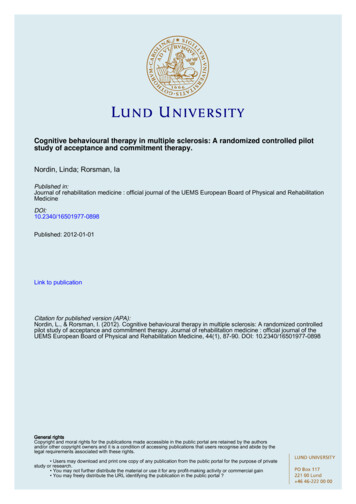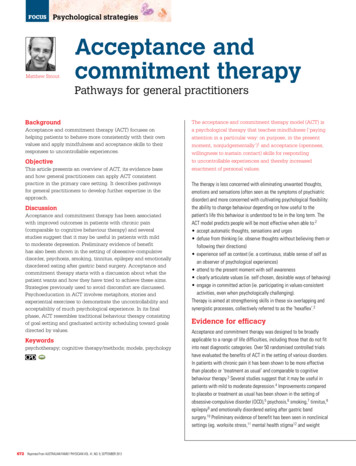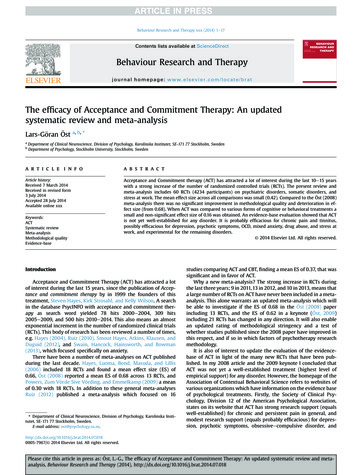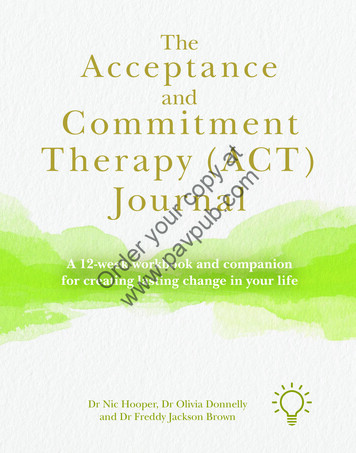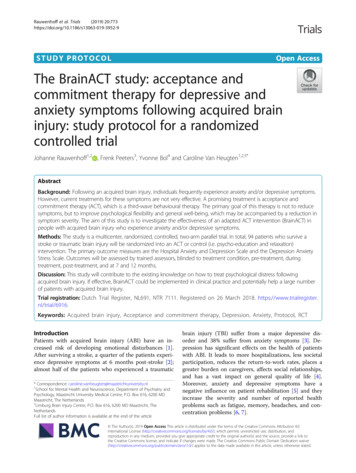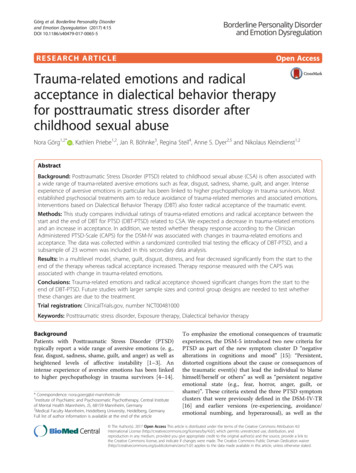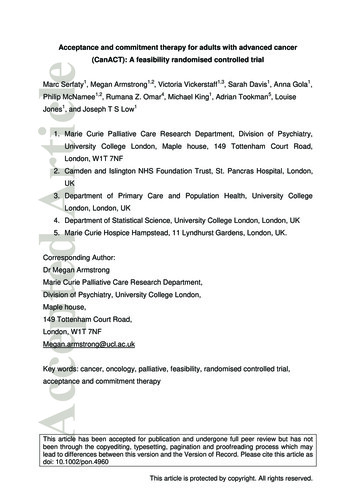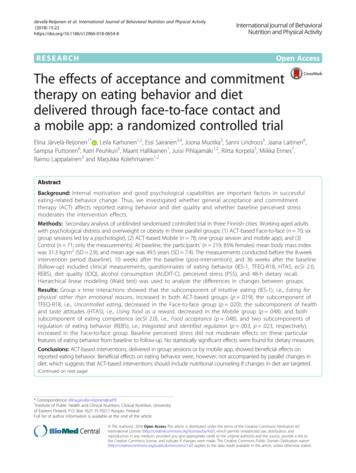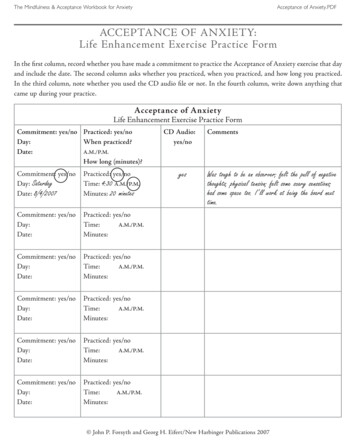
Transcription
Department of psychologyMaster Thesis, 30 hp2012Acceptance and Commitment Therapy for womenaffected by HIV, Pain and Sexual abuseA pilot study in Sierra LeoneLina JosefsonSupervisorJoanne DahlAssistant supervisorsSandra WeinelandEmma WallinExaminerNazar Akrami1
7References.552
AbstractThe consequences of war and conflict on mental health remainlong after the events are over. Several publications and reportshighlight the need for effective and cost-effective treatmentstargeting mental ill-health in war affected low-incomecountries. This study investigated the effects of a two-sessionAcceptance and Commitment Therapy (ACT) intervention onquality of life, psychological flexibility and Steps taken invalued direction. Participants were women (N 6) seeking helpfor HIV, Pain and Sexual abuse at a Non GovernmentalOrganization in Sierra Leone. A single case design withrepeated measures and pre, mid, and post-measures was used.Results show support for the interventions effect on Quality ofLife and Steps taken in valued direction. Due to the smallsample size in this pilot study the significance of the findingsis limited.Key words: Acceptance and Commitment Therapy, ACT, Pain, HIV, Sexual abuse,Sierra Leone3
This study has been carried out within the framework of the Minor Field Study (MFS)Scholarship Program, funded by the Swedish International Development CooperationAgency (SIDA).4
Eleven years after the end of the civil war in Sierra Leone, the country is stillsuffering from its aftermath. The conflict, which ended in 2001 devastated thecountry’s infrastructure, left many dead and mutilated and half of the populationdisplaced (Macauley, 2012). Sierra Leone is now an extremely poor nation, with greatinequalities in income and with one of the worlds highest infant mortality rates (CIA2012). Since the war, diseases such as HIV/AIDS, malaria and tuberculosis arecompounding the situation further (GOSL, 2005).The basis of this paper is a field study that took place at a non-governmentalorganization working to deliver psychosocial care in Sierra Leone. The aim of thestudy was to evaluate the effects of a short-term psychotherapeutic interventionoffered to women seeking help for HIV, pain and sexual abuse. The organizationwhere the study took place will be referred to in this paper as the counseling center.Women in Sierra LeoneDuring the civil war, thousands of girls and women were forced into slavelabor. Systemic sexual abuse, violence and sexual slavery were common and manywere abducted for recruitment as child soldiers (Baker & May, 2004). After the war,women are still subjected to gender violence, have less access to education as well asless power in both political and private spheres (Caulter, 2009). Additionally, manywomen are not only faced with trauma and injuries directly related to the war, but alsoimplications of poverty, low social status and fewer educational opportunities.The abduction and sexual abuse of women and girls during the war resultednot only in psychological traumas and unwanted pregnancies but also the spread ofsexually transmitted diseases. Women and minorities, particularly those living inpoverty, are now those most affected by HIV worldwide (UNAIDS, 2006).Predisposing factors such as increased levels of prostitution, intravenous drug use,traditions and norms that encourage multiple sexual partners and the low status ofwomen leaves Sierra Leone at risk of facing an HIV outbreak (Macauley, 2012).Mental Health in developing countriesWar and torture are known to be related to mental disorders. Disorders thatcause intense suffering and dysfunction and bring extensive consequences for bothindividuals and society (Betancourt & Williams, 2008; De Jong, 2002). In developingcountries, recognition and treatment of mental disorders has largely been overlooked5
(WHO, 2009). In a recently launched program called The Mental Health Gap, theWorld Health Organization (WHO) highlights the need for mental health services andpsychosocial interventions in low- and middle-income countries. According to WHO,mental health treatment should be available in the community for anyone who needsit. The Mental Health Gap Program was initiated to address the fact that more thanfour in five people in need of services for substance abuse and mental andneurological conditions do not receive help. The program further describes that whenservices are available, the interventions are often neither evidence-based nor of highquality (WHO, 2010).Cultural differences and mental healthEven though research describe a lack of resources and public institutions toaddress mental health in many developing African countries, anthropological researchhas uncovered traditional ways to deal with mental illness. These methods are oftenintegrated into social, religious and traditional structures (Patel, 1995; Utas, 2003).Additionally, the ways in which symptoms of mental illness are related andinterpreted in Sub Saharan Africa often differ from Western interpretations. AlthoughWestern influence means that traditional views are changing and approaching aWestern model of mental illness, symptoms of mental illnesses are still morecommonly attributed to external causes such as evil spirits, non-observance of taboosand consequent ancestral displeasure than to biomedical concepts (Patel, 1995). InSierra Leone, anthropological studies have noted descriptions of mental illness asbeing perceived to be outside the body and described in terms of invasion from thebush (Utas, 2003; Shaw, 2000).Patel (1995) describes psychotic illness as often recognized as “madness”,whilst less severe forms of psychiatric illness (depression, agoraphobia, somatization)are more frequently considered to be social problems. Behavioral features of mentalillness as well as somatization are more common than in Western interpretations(Patel, 1995), a contrast also observed in refugee populations (Lin, Carter, &Kleinman, 1985). Ebigbo (refered in Patel 1995) describes that in Sub Saharan Africa,the somatic localization of the soul and mind is in the chest, head and/or abdominalregions. He goes on to reason that the phenomenon of somatic presentations may berelated to this localization of the soul and mind.6
Research into mental health in conflict and post conflict settingsWhen reviewing research into mental health in war-affected countries,two main perspectives appear: trauma-focused and psychosocial approaches.Advocates of trauma-focused approaches view the direct exposure to violence anddestruction related to war as the critical factor. Typically, these are events that arepotentially traumatic, often assessed by war-event checklists (for example thedisappearance or death of a loved one and physical assault). According to this view,addressing symptoms caused by traumatic events will not only improve mental healthbut also help people to cope more effectively with environmental stressors. In contrastto this, a psychosocial approach focuses on stressors related to social and materiallosses caused by armed conflict, such as the destruction of a home, shattered socialnetworks and loss of material support (Miller & Rasmussen, 2010). Advocates ofpsychosocial approaches are less interested in individual differences and treating theindividual than in restoring the physical environment, providing predictability androutine and altering stressful conditions. According to the psychosocial perspective,this is the most effective way of improving mental health (Betancourt & Williams,2008).The main criticism facing trauma-focused interventions in post conflictsettings concerns the appropriateness of applying individualized psychologicaltreatments and models developed in the Western world in non-Western cultures. Theevidence for the efficacy of "talking therapies" is substantial in the industrializednations where these therapies have been developed, but the extent to whichpsychotherapeutic models and the strategies they use are appropriate for otherpopulations is a matter of which there is little knowledge (Bolton et al., 2003). InWest Africa, conditions differ those in which psychotherapy was originallydeveloped, something that may reduce effectiveness (Patel, 1995). In addition, manypeople live in extremely poor and unsafe conditions that are rare in developedcountries. Concerns about the barriers facing the implementation of psychologicaltreatments in third world countries have also been raised, among them the lack ofskilled human resources and the lack of resources in the health care sector (Patel,Chowdhary, Rahman, & Verdeli, 2011; Naeem, Gobbi, Ayub, & Kingdon, 2010).Additionally, some researchers have argued that symptoms described in westernpsychiatric diagnoses, like Post Traumatic Stress Disorder (PTSD) symptoms, mayhave a different meaning or value in different cultures. Meaning that it may depend on7
cultural context whether symptoms are interpreted as distressing (Nicholl &Thompson 2004). In contrast, meta-analyses show beneficial results for psychologicalinterventions as treatment for PTSD and depression in both adults and children inhumanitarian settings (Tol et al., 2011; Patel et al, 2011). Research also suggests thata narrow psychosocial focus may underestimate the severe impact that exposure towar and armed conflict can have on psychosocial functioning and mental health. Ifinterventions only target daily stressors, they may risk overlooking the need for morespecialized treatment for traumatized or depressed individuals (Miller & Rasmussen,2010).Considering the criticism of both perspectives, The Sierra Leone HumanDevelopment Report (UNDP, 2007) highlights a significant need for psychosocialcounseling focusing on trauma healing as a way of improving the livelihood ofsurvivors of the civil war across the country. In connection with this, the WHOrecommends interventions on both a societal and individual level in low-incomecountries, including Cognitive Behavioral Therapy (WHO, 2009).Cognitive Behavioral TherapyCBT is one of the most extensively researched forms of psychotherapy andhas been concluded to be clearly effective for a wide range of disorders, such astrauma symptoms and pain. (Jayasvasti 2011, Panther & Liebman 2005, Lechner et.al2003; Butler, Chapman, Forman, & Beck, 2006; Foa 2011). CBT has further beenevaluated for patients with HIV, displaying positive effects on symptoms ofdepression, on adherence and decrease in pain-related impairment (Huggins, BonnMiller, Oser, Sorrell, & Trafton, 2012; Jayasvasti, 2011). Most research of CBT hasbeen carried out in the western part of the world. However, some studies have beenconducted in non-western countries like Pakistan (Naeem, 2011), Thailand (Jayasvastiet. al, 2011), Sri Lanka (Sumathipala, Hewege & Hanwella, 2000), Kenya (Papas etal., 2010) and South Africa (Tshabalala, 2011). These studies show that CBT could bean effective treatment in low-income countries and in different cultural contexts.Quality of LifeBesides interventions and practices of mental health, the WHO is alsoresearching psychometric instruments, such as the measure of Quality of life. In anattempt to broaden the scope of the evaluation of effects of health care interventions,8
many clinical researchers have turned their attention to Quality of life assessment as acomplement or alternative to more symptom-focused approaches. The WHO defineQuality of life as “an individual's perception of their position in life in the context ofthe culture and value systems in which they live, and in relation to their goals,expectations, standards and concerns” (Skevington, S.M, Lofty, M, O’Connell, 2004p. 2). Several studies have shown that the subjective wellbeing of the client is relatedmore closely to treatment seeking behavior, compliance and evaluation of treatmentrather than the objective medical condition. The use of Quality of life measures maytherefore be a valuable alternative to statistical approaches to defining clinicalsignificance and a complement to traditional symptom-based measures (Gladis,Gosch, Dishuk, & Crits-Christoph, 1999).Acceptance and Commitment TherapyAcceptance and Commitment Therapy belongs to the wave of Cognitive BehavioralTherapy, and is based on the same learning principles as CBT, but developed within apragmatic philosophy called functional contextualism. Meaning that psychologicalevents are regarded as actions of the whole organism, interacting with and in acontext. According to the philosophy of contextualism, behavior, the environment,history, and outcome of the behavior are all part of the context and important toconsider while proceeding through therapy. Merely removal of a client's problematicbehaviors from the context (e.g only analyzing manifested behavioral symptoms) isthought to miss the cause and nature of the problem and opportunities for its solution(Hayes & Pierson, 2005).In addition, ACT uses a pragmatic criterion of truth, which means notconducting any evaluation of the right or wrong of a person’s actions. Rather thancategorizing behaviors as positive or negative, the effects of these behaviors areevaluated as consistent or not consistent with the individual’s goals and values (HayesStrosahl & Wilson, 1999). This is also referred to as workability of actions (Hayes,2004). In addition, ACT is based on a theory of human language called RelationalFrame Theory (RFT) (Hayes, Luoma, Bond, Masuda & Lillis, 2006; see alsoBlackledge 2003 for an extended introduction). Within an ACT-framework,psychological distress arises as a result of experiential avoidance, which refers toattempts to control painful feelings and thoughts even if doing so limits the quality oflife. Experiential avoidance and its relation to psychopathology has gained much9
attention in recent psychotherapeutic research (Chawla & Ostafin, 2007). In theoriesand research of ACT, experiential avoidance is thought to be critical to thedevelopment and maintenance of psychopathology (Hayes, Strosahl, & Wilson,1999). Additionally, in studies of PTSD, Pain and HIV, experiential avoidance hasshown to be related to severity of mental ill-health (Maack, Tull, & Gratz, 2011;Gonzalez, Solomon, Zvolensky, & Miller, 2009; McCracken, Vowles, & Eccleston,2004).In ACT theory, psychological flexibility is seen as contrary to experientialavoidance and refers to the ability to fully contact the present moment as a consciousperson, and based on what the situation affords, changing or persisting in behavior inthe direction of chosen values (Hayes, Strosahl & Wilson, 1999). The primary goal inACT is to increase psychological flexibility through six core processes; acceptance,cognitive defusion, contact with the present moment, self as context, committed actionand values (Hayes, 2004).Acceptance means embracing private events (thoughts, feelings, and physicalsensations) consciously and actively, without attempting to change their frequency orform, especially when doing so would cause psychological harm. Acceptance is notan end in itself but rather a way of increasing flexible actions based on values.Cognitive defusion refers to the way one relates to or interacts with thoughts.Techniques of cognitive defusion attempt to reduce the sometimes unnecessarybehavioral impact of thoughts. This is fostered by learning how to see thoughtsmerely as thoughts, and to view the process of thinking in a more mindful manner,rather than dealing only with the world structured by that thinking. The result ofdefusion is usually a decrease in attachment to or believability of private events,rather than an immediate change in their frequency.Self as context refers to an experiential contact with the self as context ratherthan content. This encourages clients to experience their own thoughts and feelingswithout identifying with a conceptualized self (for example, “I am worthless” or “Iam sick”). If one can be aware of one’s own flow of thoughts and feelings withouthaving an attachment to them, acceptance and defusion can be fostered.Contact with the present moment involves contacting the present moment as itoccurs and being able to experience the world more directly, promoting a moreflexible behavior that is thus more consistent with defined values.Values refer to the qualities in important life domains that are fundamental for10
a meaningful life. Values differ from goals in the way that they are not objects to besought, but rather directions of action that can be initiated moment by moment.Committed action involves defining the behavioral patterns and behavioralchanges that bring the client closer to value-consistent goals. Committed actioninvolves concrete and attainable short term, medium and long term goals.Additionally, efforts to change behavior often lead to contact with psychologicalbarriers that are addressed through other ACT processes (Hayes, 2004).The ACT principle states that, when conceptualizing psychopathology andpain, it is not only the severity of pain and other symptoms that influences patientfunctioning, but also the psychological relationships between these symptoms andbehaviors. Hence, the goal in treatment is not explicitly to reduce pain or distress, orto change the frequency or content of thoughts. Instead, ACT seeks to improvefunctioning by modifying the impact of pain and other symptoms through increasedpsychological flexibility (Hayes et al., 2006)Why ACT?At present, the effects of ACT have been evaluated with regard to a diverse number ofchronic illnesses and psychiatric disorders, with promising results (Hayes, BarneJolmes& Roche, 2001; Dahl, Wilson & Nilsson 2004; Gregg Callaghan, Hayes &Glenn-Lawson 2007; Ruiz, 2010). Although ACT is a relatively recent contribution inpsychotherapy, empirical support is growing and ACT is currently listed as EvidenceBased Treatment with strong support in the areas of Pain and Depression (APA,2012). In reviews of ACT treatment, a high number of these ACT studies havefeatured extremely short interventions that have shown relevant effects (Ruiz, 2010).The theoretical concept of experiential avoidance has been found to be animportant component in explaining psychopathology. ACT works specifically totarget dysfunctional behavior patterns of experiential avoidance. In the areas of Pain,HIV and sexual abuse this may be of particular relevance. Tull, Gratz, Salters &Roemer (2004) have shown the tendency to suppress thoughts and the intentionalwithholding of emotional responses to be associated with severity of trauma relatedsymptoms. Longitudinal studies of patients with HIV indicate that avoidant coping iscorrelated to greater HIV disease progression (Ironson et al., 2005a) and that denialcan increase mortality as well as predict a more rapid progression to AIDS (Ironson etal., 1994; Leserman et al., 2002). In the area of pain, experiential avoidance has been11
shown to be related to less tolerance of pain (Hayes et.al, 1999). Several studies havealso shown that emotional avoidance processes may increase pain intensity, and thatacceptance strategies can lead to improved emotional adjustment related to pain. Thisis of relevance when treating patients with HIV and AIDS since research has shownthat patients with HIV/AIDS have high rates of non-HIV related chronic pain (e.g.,musculoskeletal pain and headache), pain connected to progression of AIDS, as wellas nerve damage related to anti retroviral treatment (Huggins, Bonn-Miller, Oser,Sorrell & Trafton, 2012). Many HIV positive women in Sierra Leone also havehistories of sexual abuse, a circumstance that may further increase the risk ofdeveloping chronic pain (Larue, Fontaine, & Colleau, 1997; Linton, 1997).Additionally, one important life stressor indicating emotional distress for personsliving with HIV/AIDS and experiences of sexual abuse is self-stigma (Leserman, et.al2002). Beliefs about HIV and attitudes towards infected individuals in Sierra Leone,as well as a stigma connected to sexual abuse, leaves women at risk of selfstigmatization. ACT has been shown to reduce self-stigma in other populations, suchas substance-abuse (Luoma, Kohlenberg Hayes, Buntin & Rye, 2008) sexualminorities (Yadavaia & Hayes, 2008) and overweight individuals (Lillis, Hayes, &Bunting, 2009). Hence, ACT could be an effective method addressing ill-healthrelated to stigma for the women in this study.In summary, there is a need for effective treatment in order to counteractmental ill health and to improve the quality of life of women in Sierra Leone. Womenappear to be a more vulnerable group often faced with numerous difficulties. ACT is anew model of CBT that has shown promising results when it comes to a variety ofpsychological problems, based on the assumption that common processes underlieand maintain psychological problems. ACT is further distinguished from moretraditional methods of CBT in that it is less symptom-oriented, operating morebroadly to target the general dysfunctional behavior patterns of avoidance andpsychological inflexibility. For the reasons mentioned above, ACT could be a methodto address the diverse difficulties faced by many women in Sierra Leone. Supportedby previous studies implemented in developing countries that have used short termtherapy (Lundgren, Dahl, Yardi & Melin, 2008 and Lundgren, Dahl, Melin & Kies2006), a short term intervention was deemed the most cost effective and suitabletherapy in the case of this particular study.12
There has been only a small number of studies evaluating the effectiveness ofimplementing psychological therapy in developing countries (Stone & Warren, 2011)and, to date, no studies of CBT or ACT in Sierra Leone. There was, therefore, goodreason to in this pilot study, investigate the effects of a brief ACT intervention forwomen seeking help at a counseling center in Sierra Leone.AimThe aim of this study was to evaluate the effects of a short term ACTintervention offered to women seeking help for HIV, pain and sexual abuse at acounseling center in Sierra Leone, in terms of Quality of life, Steps taken in valueddirection and Psychological flexibility. A second purpose of the study was to gatherinformation that could generate improvements of the intervention as well ashypotheses for further research.Research questions1. What are the effects of the ACT intervention on the dependent variables: Quality of life Steps taken in valued direction Psychological flexibilityin participants’ pre- and post-measures?2. What are the participants’ perceptions of the intervention with regard to itsimportance and the extent of the support it provided?MethodParticipantsThe participants were six women seeking support at a counseling center inSierra Leone. Table 1 presents summarized information of the participants’demographic characteristics regarding reason for contact with the organization,multiple problems, tribe, number of children and educational and economical status.The mean age was 38.67 years (SD 6.15, range from 33 to 50 years old). Three of the13
women came into contact with the organization after being diagnosed with HIV, twoof the women because of a history of sexual abuse, and one woman came in contactwith the organization due to reoccurring headaches.HIV, pain and sexual abuse are known to be related, as experienced in the casefor the women participating in this study. Therefore, Table 1 shows how many of thewomen were treated for problems relating to one of the three areas other than thatwhich they primarily sought help for. For example, one of the women with HIV hadbeen abducted and sexually abused during the war, and the women seeking help forsexual assault had experienced pain. One of the women with HIV also suffered fromrecurring headaches. Headaches were the most common type of pain experienced,followed by pain in the stomach and the pubic area. With regard to educational status,all but one of the women participating in the study had completed secondary school.One of the women had learnt to read and write through adult education and four of thewomen had undergone vocational education following secondary school. Of these,one had completed a course in catering and another participated in courses in cateringwhen she had the opportunity. One of the women had completed hairdresser trainingand another had begun a course in computer studies, although had been unable tocomplete the course due to illness.Four different tribes are represented, correspondin
Acceptance and Commitment Therapy (ACT) intervention on quality of life, psychological flexibility and Steps taken in valued direction. Participants were women (N 6) seeking help for HIV, Pain and Sexual abuse at a Non Governmental Organization in Sierra Leone. A single case design with
